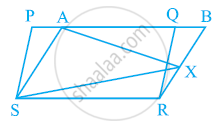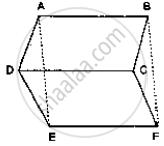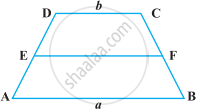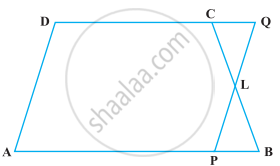Advertisements
Advertisements
प्रश्न
The diagonals of a parallelogram ABCD intersect at a point O. Through O, a line is drawn to intersect AD at P and BC at Q. Show that PQ divides the parallelogram into two parts of equal area.
उत्तर
Given: In a parallelogram ABCD, diagonals intersect at O and draw a line PQ, which intersects AD and BC.
To prove: PQ divides the parallelogram ABCD into two parts of equal area.
i.e., ar (ABQP) = ar (CDPQ)
Proof: We know that, diagonals of a parallelogram bisect each other.
∴ OA = OC and OB = OD ...(i)
In ΔAOB and ΔCOD,
OA = OC
OB = OD ...[From equation (i)]
And ∠AOB = ∠COD ...[Vertically opposite angles]
∴ ΔAOB = ΔCOD ...[By SAS congruence rule]
Then, ar (ΔAOB) = ar (ΔCOD) ...(ii) [Since, congruent figures have equal area]
Now, in ΔAOP and ΔCOQ,
∠PAO = ∠OCQ ...[Alternate interior angles]
OA = OC ...[From equation (i)]
And ∠AOP = ∠COQ ...[Vertically opposite angles]
∴ ΔAOP ≅ ΔCOQ ...[By ASA congruence rule]
∴ ar (ΔAOP) = ar (ΔCOQ) ...(iii) [Since, congruent figures have equal area]
Similarly, ar (ΔPOD) = ar (ΔBOQ) ...(iv)
Now, ar (ABQP) = ar (ΔCOQ) + ar (ΔCOD) + ar (ΔPOD)
= ar (ΔAOP) + ar (ΔAOB) + ar (ΔBOQ) ...[From equations (ii), (iii) and (iv)]
⇒ ar (ABQP) = ar (CDPQ)
Hence proved.
APPEARS IN
संबंधित प्रश्न
In the given figure, PQRS and ABRS are parallelograms and X is any point on side BR. Show that
(i) ar (PQRS) = ar (ABRS)
(ii) ar (AXS) = 1/2ar (PQRS)

In the given figure, P is a point in the interior of a parallelogram ABCD. Show that
(i) ar (APB) + ar (PCD) = 1/2ar (ABCD)
(ii) ar (APD) + ar (PBC) = ar (APB) + ar (PCD)
[Hint: Through. P, draw a line parallel to AB]

Parallelogram ABCD and rectangle ABEF are on the same base AB and have equal areas. Show that the perimeter of the parallelogram is greater than that of the rectangle.
In the given below fig. ABCD, ABFE and CDEF are parallelograms. Prove that ar (ΔADE)
= ar (ΔBCF)

ABCD is a parallelogram, G is the point on AB such that AG = 2 GB, E is a point of DC
such that CE = 2DE and F is the point of BC such that BF = 2FC. Prove that:
(1) ar ( ADEG) = ar (GBCD)
(2) ar (ΔEGB) = `1/6` ar (ABCD)
(3) ar (ΔEFC) = `1/2` ar (ΔEBF)
(4) ar (ΔEBG) = ar (ΔEFC)
(5)ΔFind what portion of the area of parallelogram is the area of EFG.
In the below fig. ABCD and AEFD are two parallelograms. Prove that
(1) PE = FQ
(2) ar (Δ APE) : ar (ΔPFA) = ar Δ(QFD) : ar (Δ PFD)
(3) ar (ΔPEA) = ar (ΔQFD)
ABCD is a trapezium with parallel sides AB = a cm and DC = b cm (Figure). E and F are the mid-points of the non-parallel sides. The ratio of ar (ABFE) and ar (EFCD) is ______.

PQRS is a rectangle inscribed in a quadrant of a circle of radius 13 cm. A is any point on PQ. If PS = 5 cm, then ar (PAS) = 30 cm2.
In the following figure, PSDA is a parallelogram. Points Q and R are taken on PS such that PQ = QR = RS and PA || QB || RC. Prove that ar (PQE) = ar (CFD).

In trapezium ABCD, AB || DC and L is the mid-point of BC. Through L, a line PQ || AD has been drawn which meets AB in P and DC produced in Q (Figure). Prove that ar (ABCD) = ar (APQD)

